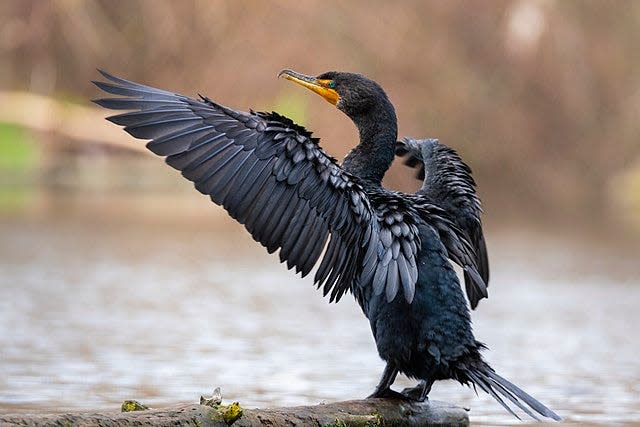Double-crested cormorants: Why these sun-worshipping seabirds are a foe to fishermen
Cormorants have been the bane of fishermen since time immemorial.
They are a very recognizable black and gray seabird with a very long neck and a voracious appetite for fish.
These birds can be seen on any dock or rock that protrudes in the Gulf of Maine. They are also found inland to the Great Lakes and the east and west coast of North America.
Historically, commercial and recreational fishermen have harbored a hatred of these birds as they compete with humans for the valued wild and aquacultured fish supply. The birds swarm in flocks, voraciously feeding by diving on aquaculture facilities and schools of fish.

During the 1960s, at the height of the pesticide DDT, the number of cormorants dwindled drastically, but when the substance was outlawed, their numbers came roaring back.
In some areas of Canada and the United States, the numbers of cormorants have been culled by both governments to protect other birds and fish stocks in recent years. The U.S. Fish and Wildlife Service says double-crested cormorants became part of the Migratory Bird Treaty Act (MBTA) in 1972. The MBTA is based on four conservation treaties with Canada, Japan, Mexico, and Russia. The treaty protects certain migratory species from killing, trading, harming, etc., without government permits.
How I met a slime star: A rare and slimy encounter in the Gulf of Maine
In New England and throughout the Gulf of Maine, the cormorant we see is the double-crested cormorant. They are blackish-brown birds with bald, light yellow faces and dark beaks with a hook on the end of the top beak, which aids in capturing their prey.
Cormorants develop feathery crests on each cheek and a yellow face patch during mating season. Their juveniles are mostly gray with a pale underside and beak. I have never seen one in mating plumage, and I hope to one day witness this as their head looks quite comical. The most easily recognizable feature of their behavior is seen just after they dive into the ocean to catch a fish. They have oil glands, like most other seabirds, but they do not secrete enough oil to waterproof their wings and spend most of their time on rocks and pilings, with wings and heads outstretched to the sun. With their head tilted toward the sun, the birds appear to be worshipping the sun gods. This allows them to dry their feathers until they contemoplate their next meal.
I love to watch flocks of cormorants skimming just above the water, single file, as if an invisible force is pulling them along the waves. They can also be seen in a V formation in the evening when whole flocks return to their roosting areas for the night.
Killer whales attacking sailboats: Revenge or something else going on?
These birds are so versatile. They nest on rocks, islands, cliffs, and even in trees and are often found nesting alongside other sea birds. They are sexually mature at three years. The female builds the nest while the male is delegated to find the proper nesting materials, sticks for the exterior, and softer, smaller materials for the inner sides. According to the U.S. Fish and Wildlife Service, cormorants lay an average of three eggs. Both the male and female tend to the eggs, which hatch after about 30 days. The young are fully fledged in about five weeks.
Worldwide there are 42 species of cormorants. In the U.S. there are six, and in New England, there are two, the great cormorant and the double-crested.
The great cormorants mostly nest in Atlantic Canada and the northernmost points on the Maine coast. We do not see them in New Hampshire. The species found on our coastline are double-crested cormorants, and they are the most abundant ones found in the U.S.
Cormorants can dive up to 24 feet and sometimes swallow the fish before they reach the surface. With larger fish, they will bring up their catch and finish their meal on land. The birds main diet consists of small fish, and they eat about a pound of fish a day, according to the Fish and Wildlife Service. They are adaptable in their feeding preferences and will eat crustaceans and most anything they can find when fish is in short supply. They regurgitate pellets of indigestible material (bones, scales, and exoskeletons) after their meals, like owls.
During a trip to the Galapagos Islands in Ecuador, I had the opportunity to view the flightless cormorant. These cormorants have short stubby wings, and with those wings, can dive to amazing depths.
Other than that, they resemble our double-crested cormorants. They also spend hours drying their bodies and wings in the sun on rocks and promontories before they can catch their next meal.
Although recreational and commercial fishermen often despise the cormorant for stealing their bait or fish from nets, I have always had a soft spot for them. I love the graceful way the flock follows each other, skimming the surface of the ocean, and the Vee’d flocks, soaring to their roosting grounds on the Isles of Shoals. I also love the way they dive into the water and emerge with a full crop or a fish in their mouth. I hope you will take a moment the next time you are at the beach to watch these unique seabirds.
Ellen Goethel is a marine biologist and the owner of Explore the Ocean World at 367 Ocean Blvd. at Hampton Beach.
This article originally appeared on Portsmouth Herald: Double-crested cormorants: The seabirds that fishermen love to hate

